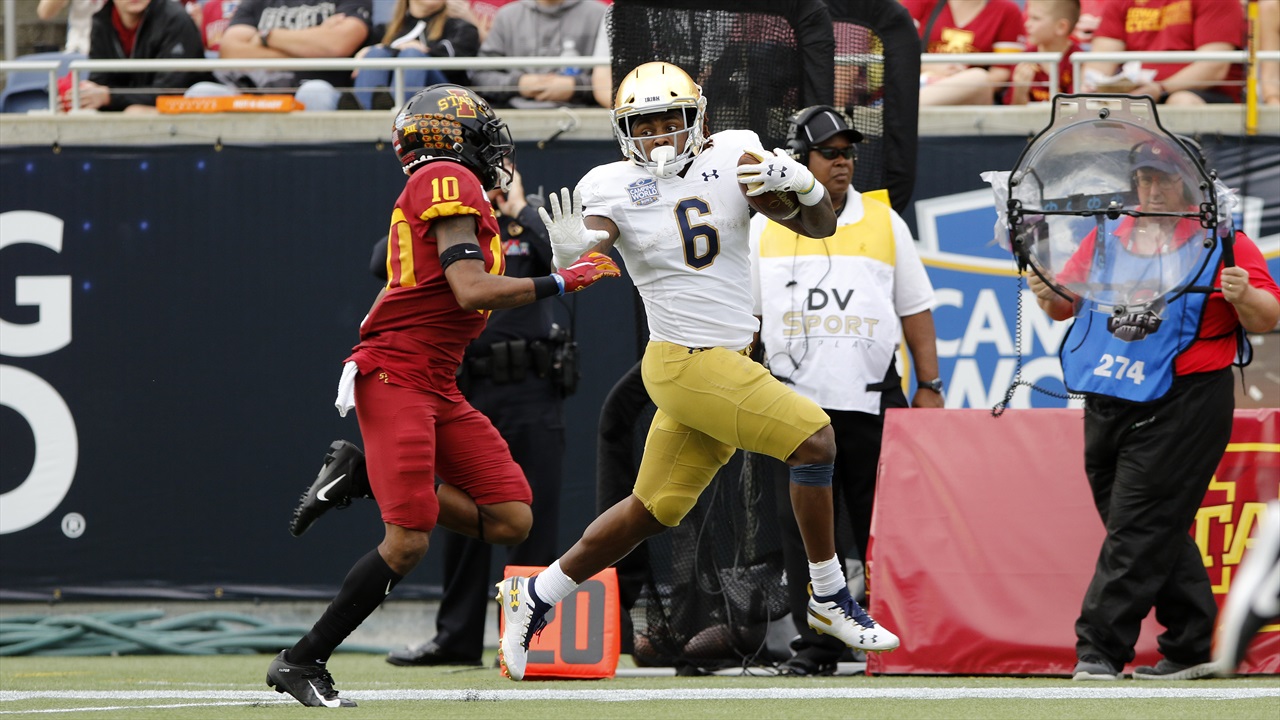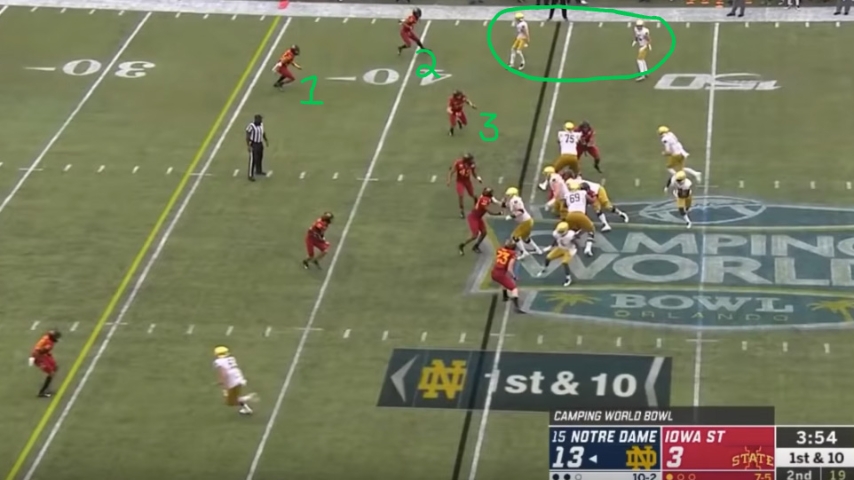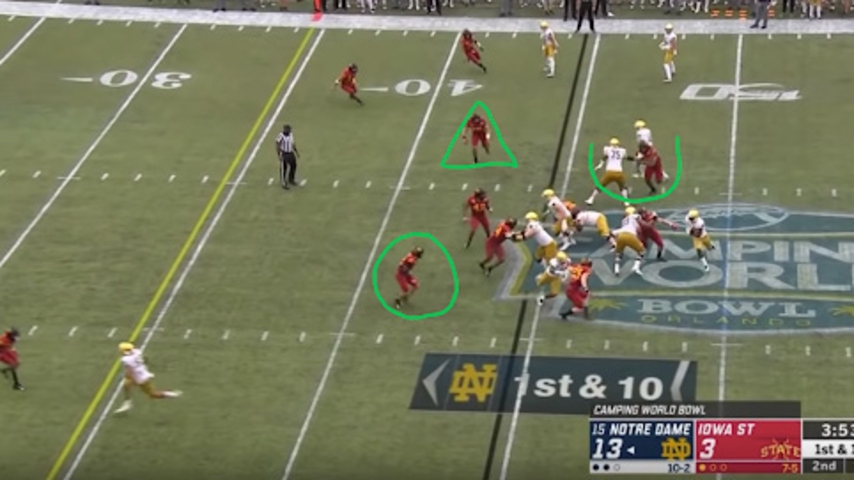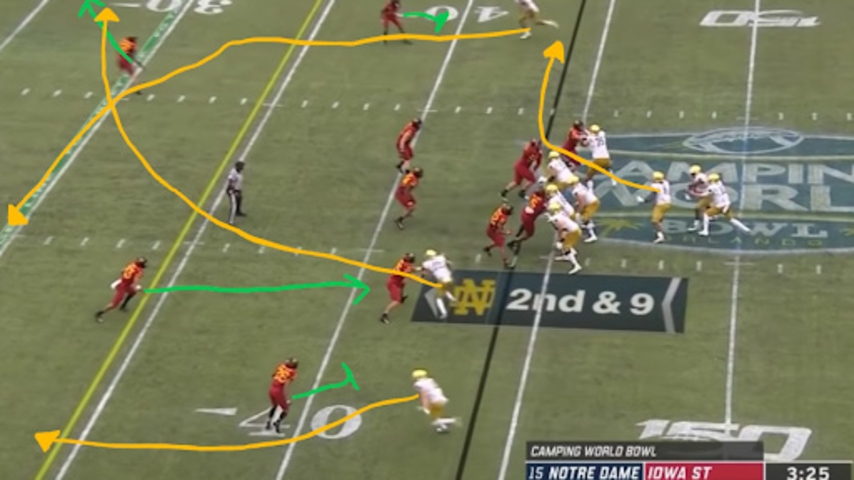
Inside The Headset | More TD Drives From Tommy Rees
“Coach Sting” is a current coach who has spent time on both the high school and college level. He’ll be offering his expertise to Irish Sports Daily by diving into Notre Dame film and explaining what he sees.
So excited to be back as we continue to break down the remaining touchdowns from the Irish’s bowl win over Iowa State and continue our dive into the success Tommy Rees had in his debut as Notre Dame play-caller.
There are two more touchdowns in addition to the one already broken down in the last edition of “Inside the Headset.” The rest of the Irish scores came by way of field goals.
In the following, we will look at two running touchdowns; one coming with 2:27 to go in the first half and the few plays that led to the 1-yard plunge and the other, an 84-yard scamper from Tony Jones Jr on the first possession of the second half.
6TH OFFENSIVE SERIES
PLAY 1
1ST & 10
After a second 4th & 1 stop and turnover on downs forced by the ND defense, the Irish found themselves with the ball at the Cyclone 44-yard line.
On first down, Rees trots out his first 20 Personnel Formation (2 Backs, 0 TE) with shotgun and split backs. C'Borius Flemister is set strong (to the stacked two WR side) to Ian Book’s right and Jones weak, on Book’s left.
In full disclosure, there is not a great film of this play on file, so we don’t get the best look pre-snap. However, while we were able to break down “RPO’s” (Run-Pass-Option’s) in the first edition of “Inside the Headset,” this is a different type of RPO.
True RPO’s have a full read “post-snap,” as they force a particular player into a conflict to whether or not he plays run or pass when the ball is snapped. They usually have pre-snap Pass Options as well, lots of times they exist on both sides of the formation.
For this play, there is a quick pre-snap “yes/no” or “gift” option, to the two-WR side. As you can see here in the next image, as always, it’s a numbers game. The Irish have 2 WRs stacked one on the other to the right and the Cyclones have 3 defenders in the vicinity. Clearly, it’s a disadvantage to throw it out here to Braden Lenzy.

Generally, when coaching a QB on pre-snap rules, you count any defender within 8 yards of the line of scrimmage.
The safety (labeled #1 in the illustration) is close, however when there is any doubt about factoring him in the count, the QB checks his pre-snap demeanor. Here, because he is a primary run defender in this coverage, he is playing flat-footed and therefore ready to trigger on any run his way or a quick throw to the perimeter. He would have to be “creeping” or starting his back-peddle slowly prior to the snap or - at the very least - crouched over and ready to engage in a “pedal” position for him not to be factored in the count at all. None of that was the case on this play.
If the read is somewhat “muddy” or the QB just isn’t sure, they may count the safety as a ½ of a defender for the purpose of checking to see if there is a numbers advantage or not. Even if this was the case, and Book liked the soft CB (off-corner coverage), he still has at least “2.5” defenders, to ND’s two-WR side. All of this to say that the pre-snap read to just rip it to Lenzy is off the table, so let’s take a look at the run called.
Rees once again goes to a Lead Wide Zone here, but yet again uses a completely different look to do so. The theme of the offensive game-plan still rings true. Keep running the same plays out of different looks (different personnel, formations, motions), as we got into a little deeper in the last ITH.
With plenty of prior success in this game with Lead Wide Zone with the QB under center and an H/Fullback type leading the way downhill, Rees takes a shot at this play with Jones as the lead back.
Numbers for the Irish are great here when you look at the box (the area around the ball - 1st & 2nd level players - from tackle to tackle). There are six defenders in the box, if you include #23, again an undersized DB who Iowa State continues to sacrifice in trying to set an edge.
Before this play, ND has put a large TE on the Cyclones’ edge player. But here, Jones is tasked with this. At first, it looks as if Jones “whiffs” on his block and is the reason for the breakdown in the play.
However, this “lead” block on Wide Zone is not like an isolation or power play where this block needs to be devastating. In fact, on this play, it is quite the contrary. All you need at the point of attack in Wide Zone is to take the edge player one way or the other, oftentimes laterally, but where he goes is not important. The key is that the block is a clear read for the ball carrier. While Jones does not do his best work here as the lead blocker, he gets just enough.

The real problem with the play is that no one accounts for the safety (the player circled above) as he immediately triggers to run the alley and force everything back inside, thus allowing #23 to get involved with the play.
I talked last time about “spy” blocking or “push-crack” blocking by the outside WRs. The last article complimented the Irish execution on this and talked about how important this is versus a team who uses their safeties as primary run defenders. This play is an example of not using this technique and therefore you see the result; a one-yard gain on a run that they had a numbers advantage against prior to the snap.
In Chase Claypool’s defense here, this is much easier to achieve when the ball is on the hash and the play is run into the boundary side -- simply a matter of less area to travel for the WR. In this case, the ball is set on what is called the “Right Middle,” which is aligned roughly with the right upright of the goal post. In practice, coaches will set the ball on the Right Hash, Right Middle, Middle, Left Middle, and the Left Hash, constantly changing these, usually in some sort of sequence.
Because the ball is not on the hash, Claypool needs to cut down his split in order to get the safety here. He does cheat down a little, but it proves to be not enough. All of this leads to the playside safety being completely unaccounted for.
Because the Irish are six players for six players in blocking the run, the backside tackle -- Josh Lugg -- is able to turn back on the backside end. Normally, in a shotgun run with no TE, the DE would be read and not blocked. This is illustrated in the “U” above. What does this mean for Ian Book and his read? It all goes back to his pre-snap look at 2.5 or 3 over 2.
After the ball is snapped, he puts his eyes to the overhang defender, who is highlighted with a “Triangle” above. If that defender ran in right away, Book would have the option of attacking that area on the ground and potentially “flipping” it out to Lenzy late. All and all, the biggest benefit to this play is Rees showing Run from Split Back Gun out of 20 personnel. This one-yard gain is great to set up the next play call.
PLAY 2
2ND & 9
Rees keeps the same personnel on the field and sets virtually the same formation as first down, the only exception is the 2-WR is set to the left and not stacked this time.
This is a Play-Action Pass and it is extremely strategic, all playing off of the safety playing run and attacking this exact area of the field. Rees also shows “Split Zone” Action in the backfield. The Irish ran Split Zone in the first series of the game, as described in the first edition of “Inside The Headset.”
Lots of prominent coaches have said that the best Play-Action Passes involve a puller from an OL. I also believe in this philosophy, however the downside is the pass protection, as you are naturally leaving some holes up front and leave yourself vulnerable to penetration due to lack of favorable angles across the line of scrimmage. Therefore, the next best thing is to have some sort of “Split” Action in the backfield.
This Split Action gives the LB’s and, in this case, a run-support safety, something that flashes in front of their face across the formation. While this is not as “run heavy” as a pulling guard, it happens fast and can be enough to freeze a defender just long enough. All of this while being in a much safer pass protection, as the OL is in a base Pass Pro and able to take a more traditional pass set, which will also give them better angles. If you notice, the Irish are coached up well here to fire off the ball with low helmets and pad level initially, further selling the Run Action and then immediately get into their pass sets.
Jones Jr. is the back going in the opposite direction of the run for additional pass protection, but because his LB does not blitz, he heads out into the flat (the Underneath Zone from the hash to the sideline). The Cyclones rush 4 here and the Irish have a 7-Man Protection set and with Jones out, it remains 6 for 4 rushers, hence all of the time for Book to move and slide -- making the big throw down the field.

Along with Rees dialing up the perfect call here, he also gets a completely blown coverage at the start of this play.
As you can see in the clip, the corner at the bottom of your screen (#26) is confused and looking for a call right before the ball is snapped. The backside safety up top is playing a “Cloud” coverage over the single WR, Claypool. This is a version of what the NFL often calls “bump & run coverage” or double-coverage over a receiver who is the biggest threat or has been hurting a defense within a game, such as the case with Claypool so far in this contest.
The irony here is the Cyclones actually execute that part of the coverage and bust with the corner and safety at the bottom. If they want to run a Cloud coverage or double-cover Claypool here, the safety rotating down (#26) would have to work to the middle of the field deep and the CB to the bottom (#26) would need to bail and take a deep third of the field in order for this to be a sound coverage.
Book initially misses the easy touchdown. Because the CB over Chris Finke doesn’t get the call, he acts like a primary run player and steps up. In addition, the safety (#23) flies down to support the run as well, therefore leaving Finke as open as anyone will ever be in major college football, or HS...or Pop Warner, for that matter.
This is an area where the Irish were really hoping Book would improve this season and there is no better example of both sides than right here on the same play. Book misses the throw that was not built into the read, because he did not see the broken coverage, yet, puts the ball in the exact right place for where the play was designed. To be an elite quarterback, he needs to be able to key the safeties pre-snap before every play. This is where a Quarterback’s pre-snap processing should always take place. Had he done so here, he could have and would have tossed the alley-oop layup to Finke for an easy touchdown.
Instead, Book goes through what looks like his full progression. He starts to his right side, then resets his feet to throw it down the field on the left hash, the exact area he knew (and Rees knew) would be vacated by the safety due to the Play-Action in the backfield. Except, in this play, there is no progression to the right side - he initially sets there simply to influence the safety at the top to work that way. With Lenzy in the slot to the bottom, his only job is to clear out the area 35 yards down the field with Claypool underneath him on the Deep Crossing Route.
To Book’s credit, while he missed the easy one in busted coverage, he executed the entire play as designed, perfectly. On the Play-Action, he needs to lower his front or downfield shoulder pad to give the presentation of Run and then quickly show the possibility that he could keep it and run himself. He does exactly that, which draws the playside safety into the run, and then he resets his feet to gain depth away from the Line of Scrimmage and pass Rush.
Because of the twist up front with the single LB who rushes and the 3 DL, Book slides to his left and you can see his back foot move first. This is key and shows how well-coached he is. Quarterbacks like Tom Brady (no, I am not comparing Book to Brady) have made a full career out of subtle pocket movements just like this.
Moving the backfoot first is key and movements have to be “subtle” by taking small steps only. If Book moves his front or downfield foot first, he would not be in position to throw the ball at any time. He would have to get his back foot in line first and then release the football.
By moving his back foot first, this allows him to throw right away when a WR pops open. Subtle movements are also key because if you take steps that are too wide, even properly with the back foot, a quarterback loses his base and again is not in position to throw. Usually in a standard “U Shaped” pocket (this is different since it only collapses on his right side), if you take huge steps in your slide, the QB generally puts himself in harm's way on the side he’s sliding too.
Book slides perfectly and delivers another strike to Claypool. It was originally ruled a TD, but after further review, the ball is placed on the 1-yard line.
PLAY 3
1ST & GOAL FROM THE 1
Rees goes with the exact same look for QB Sneak as he did with 5 minutes to go in the 1st Quarter.
This was analyzed in the 2nd edition of ITH. This is not surprising, because there is no way to have enough practice time to carry more than one specialized QB sneak in a given week. You may ask, can’t you run it out of any type of formation and motion? The answer from most Offensive Coordinators would overwhelmingly be “No.”
Regardless of the simplicity of a play, OC’s never want to put their players in situations that have not been exactly rehearsed throughout the week. Yes, even for something as “simple” as a QB sneak with motion. In fact, some may argue especially in a situation like this.
You have to analyze the “risk/reward” of each play. If you run a shift or motion that the offense has not practiced all week and they jump offsides, ND would obviously be penalized 5 yards. Conversely, if it is a success, they can only possibly gain 1 yard. Bad risk/reward to add a motion or wrinkle they are not used to.
On the flip side, this is why you often see “hard counts,” funky motions, etc when coming out (on say, the -1 yard line) when an offense is backed-up. In that scenario, your cost/benefit is risking “half the distance (½ of a yard in that case)” while possibly gaining 5 yards of breathing room if the defense jumps offsides. Great risk/reward and therefore why you see so much of this coming out of your own endzone.
Back to the play at hand. Using the same exact formation and motion as their first QB sneak, this one does not have the same impact on the LB’s eye discipline. In fact, if you view the clip, you can see that it does not influence them at all. It does widen the edge just like last time, but that is not enough. Jones does a nice job pushing Book (unfortunately, this is now legal - unlike the dreaded Bush Push, which was illegal at the time. The rule was changed to make it legal to aid a runner in 2013), but it’s not enough to cross the goaline. The Irish are left with 2nd & inches.
PLAY 4
2ND & GOAL FROM THE 1/2-YARD LINE
Rees trots out a 32 personnel formation (3 backs, 2 TE). Actual personnel is 4 TE’s, but they align in a 32 personnel heavy set formation. Iowa State counters with a 6-3 goalline defense with everyone condensed, both cheating up, but also squeezed down horizontally. This defense is common vs. a heavy set, with a couple exceptions.
Generally, Sam and Will LB (Strong & Weak on each side of the Middle LB) align wider to cover the only bubbles in the defense created with condensed DE’s. Also, the CBs on each side are usually wider to “box” anything their way and not allow a quick toss just like this, outside of them. Since the Cyclones instead squeeze everyone down inside, this is the perfect call!
When you run a Heavy Quick Toss on the GL, the RB is instructed to run a full sprint to the near pylon, exactly what Jafar Armstrong does here. If for some reason, the defense had anyone over-pursue and stretch along with him, he would then stick his outside foot in the ground and plunged into the endzone as low as possible.
The Irish just barely avoid a penalty here with Tommy Tremble escorting Armstrong into the end zone. On the quick “sandbag” motion (motion usually with a FB/H that shuffles and is square to the LOS), Tremble should “performance align,” meaning get into a position that is optimal. In this case, that means he should be wider and therefore sealing an edge. If so, the edge defender (#12) would be inside of Tremble and then he would have used a cut-block.
Since he is outside of him, he cannot cut him and must try and block up high at the beginning of the block. If he starts to feel separation he should then turn it into a modified cutblock. He has to be careful with his outside arm here, as he is close to a holding call that he can’t hide from, as he is the lead back out in the open. Tremble lets go just in time and the result is the Irish going up 20-3 in the first half!
8TH OFFENSIVE SERIES
PLAY 1
1ST & 10 ON THE MINUS-16-YARD LINE
The Irish score their third touchdown of the game in dramatic fashion, with an 84-yard scamper from Jones.
While watching this without a replay, one would first think that Rees must’ve drawn up a “gimmicky” type play with lots of bells and whistles, in order to pop such a long run. However, when you run this play back, it is simply just more of the same from Rees and the Irish for this game and that is the beauty of it.
There is genius in simplicity and all this amounts to is the exact same Wide Zone Lead that opened up their opening touchdown drive (see the 2nd ITH). The only difference in presentation here is that ND starts in Twins to the right and motions Finke over to a Balanced Formation, with Tremble offset to the TE side. After the motion, the Irish ended up in exactly what they lined up in for the opener in the first touchdown drive mentioned.
In no surprise, the exact same execution happens, with a few slight differences on the defensive side of the ball.
Because of the motion with Finke, the overhang defender (#23) stays wide on the backside. This is a key contrast to the same play referenced in the first quarter, because on this play, he cannot get involved with backside pursuit. There is too much ground to cover and he has no chance to get on Jones’ tail. The same goes for the backside safety, as you can see in this clip that was displayed in the last edition of ITH as well, when I wrote about that TD drive.
In the first quarter play, the backside safety rotated to the middle of the field, because that’s what the coveraged called for. Here, he bumps over with motion and tries to take an angle to the ball carrier on a downhill path. He should be coached to run more of a banana type path, but instead he goes straight to the ball and misses. Finke does another great job in his “spy block” and as I wrote last time, any time you have your lead fullback blocking a CB, you are in great shape.
Take a look at the same play in the first quarter.
After diving into all of the touchdown drives and plays, you can see that Rees is very confident in his debut. Keep it simple for the offense, particularly the OL, who have to block the same plays versus countless fronts and movements. All while presenting it in slightly different ways to keep the defense guessing. Therefore, it is simple for your offense, but appears complex for a defense. This is what every offense strives for and is a great sign for the future of the Irish offense!